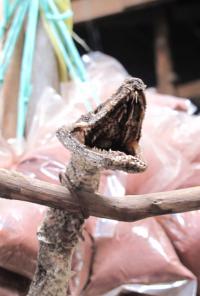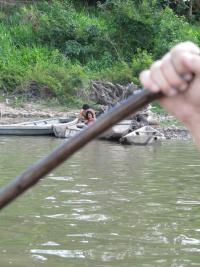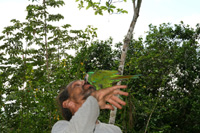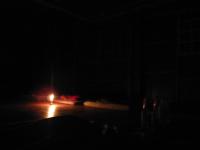EXPLANATION
How to explain these unbelievable experiences? “I felt like I saw something important, but what was it all about?”
If we reject the possibility that ayahuasca triggers only insignificant hallucinations, and if we allow that it actually reveals something about the nature of reality, we soon encounter a problem with objective description. The experience itself is often very emotive, visual and non-transferable; that is, far beyond words, language, dogmas and elaboration of ideas. If we want to talk about it, the resulting statement will be always a product of the person who is interpreting it — the terms and comparisons they use, whether from existing religions, philosophical and scientific traditions or brand-new descriptions and contexts from their experience. In the altered states of mind, we each become a small child without the expressions and words to describe the trip to the foreign lands we are discovering. Further on I will attempt an interpretation that will be as simple and consistent as possible and not based on any existing school of thought. Many of my conclusions will remind you of the opinions of various philosophical-religious systems, if only because originally all these ideas were most likely established on the basis of experience with an altered state of consciousness that provided human beings with similar insights into the nature of reality.
The basic message that ayahuasca brings is the following: Every living thing, including humans, is part of one consciousness that is, because of connection with a particular being in space and time, schizophrenically divided into countless pieces that seem to be completely self-reliant and separated from the original whole. To oversimplify: It is like a special game in which a child plays with board-game tokens. The child creates special roles for his characters — a king for a while, then a prince, servant, or princess, then suddenly a soldier and then a bad dragon. In reality, there are no kings, dragons or princesses, but only one consciousness that is playing and giving life to the pieces and spinning their stories. Of course, the more the child puts his awareness into the characters, and the more he believes the roles and forgets that it is only a game, the fuller and more authentic the stories and their drama and thrill are.
This understanding has far-reaching implications. In the conventional approach, EGO and the identity of the individual represent an appreciated value through which we perceive the world. Consequently most human acts are usually based on the benefit for the individual at the expense of the whole, which the individual EGO does not feel to be part of. By contrast, ayahuasca reveals the holistic (and therefore ecological) nature of reality, when true happiness and fulfilment come from the realization that EGO/individuality is an illusion and that every human being is an inseparable part of every living thing. Joy comes only from living in balanced connection with all the surroundings.
If this is our true nature, however, then why is the common human consciousness based on such a strong experience of EGO and on separation? For what reason do most human beings fall for the relentless pursuit of such values of the conventional world as power, status and money (which are, from a holistic point of view, quite irrelevant as they are transitory)? The point is that every living thing exists within the sole, dynamic process of creation. The new is born and the old dies so that the most varied combinations of forms can come into being. A basic feature of the separated consciousness is the awareness that is constantly hungry and eager for new experiences. Stronger emotions (either positive or negative) represent better feed for the consciousness. It is thanks to this tension — the desire to feed one’s awareness — that people pursue their own stories, experience ups and downs, and the cosmic drama of creation becomes so diverse. If we use some simplification we can say that, from the point of view of the process of creation, what is wanted is not hosts of enlightened beings in calm balance with the world around them, but rather EGOs immersed deeply in their illusionary reality who strongly experience their individual adventures. The creation itself is a passionate activity completely based on LACK OF AWARENESS of the cosmic play's participants, because if they could discover what it is about and stopped believing in it, they would laugh at their roles and leave the stage.
In other words, every living thing is mutually connected and basically shares one consciousness, but this fact has been quite forgotten at the level of individuals. Consequently, if a murderer looks in the eyes of his victim, he looks into his own eyes. (This understanding probably gave rise to the concept of karmic law peculiar to several eastern religions.) However, both parties play their roles honestly and are totally unaware of the true nature of things. Thanks to this trick, consciousness can explore an endless wealth of forms of experience and perceive continually new states of existence, because the process of creation, the cosmic psychodrama, is dynamic and endless. In the altered state of mind it becomes obvious that the usual identification with our body is not permanent, because every part of consciousness is at the same time whole and connected to all beings. During the session , it is therefore possible to become a huge sequoia tree or a monkey in the jungle struggling for nourishment and with its position within the troop, and experience a wide range of inhuman emotions that are connected with such forms of existence. But when evaluated from the point of view of human ethics, this revelation has unexpected consequences owing to apparent paradoxes, such as when a child’s suffering for a lost toy can appear essentially identical to the pain of a husband who has lost all his family. Only the form of identification and the subsequent strength of individual experience matter. No objective evaluation exists because neither situation has absolute relevance. Neither the loss of a toy nor the loss of a body/human identity in any way disrupts the continuity of perception of the universal consciousness. The cosmic play goes on in other and in other forms, and so evaluation is always connected only with subjective interpretation given to subjective experiences within their own limited world by the individualized consciousness — which is, however, a fiction in principle.
And that is where we get to the core of the ayahuasca gospel. Since our identity is an illusion and true nature is one universal, endlessly playing consciousness, we can be — and truly are — anything at all. We can hardly escape the limits of our body in this world or from our own “human role”, of which we have been convinced from a very young age, yet each of us every day participates in the cosmic play, where everything is mutually interconnected and our lives make sense only as parts of the whole. Therefore if we open our eyes and hearts and try to cross the boundaries of ego and individual consciousness through, say, one of many spiritual practices, our life will become full of signs and meaningful coincidences that will lead us forward on our journey. As the child from the example above realizes in the game that one of his tokens is threatened and sends another to help it, creating a dramatic plot, so the world around us interacts constantly with us if we allow for this interaction. That is the substance of the phenomenon of Jungian synchronicity, whereby we become astonished witnesses of significant, statistically improbable coincidences that cannot be explained in terms of linear causality, the direct relationship of cause and effect (C.G. Jung: Synchronicity: An Acausal Connecting Principle, 1960).
If there is any real goal in the life adventures of human beings, then it is the effort to awaken, to reveal our true nature, to return from the separated EGO to the whole. Therein lies the basis of eternal desire and discontent that we try to chase away with activities and pleasures in the material world. But we can never succeed in this effort in the long run because the striving and satisfaction-seeking EGO that we constantly identify with is simply not our true nature. In fact there are no boundaries for the consciousness between the human psyche, an arbitrary part of being, and the creative principle. So every experienced story, if it is fully conscious and processed, eventually presents only a small step on the “spiritual” journey back to this awareness. Does the described concept sound a bit crazy? Think for a while about the crazy concepts of the nature of the world that modern physics compels us to trust. Moreover, the ayahuasca experience is not the only source of this belief. Besides psychedelic substances (called entheogens in modern language), an altered state of mind can be achieved through various religious or pragmatic techniques of mind work (although usually not in such an effective form) and the nature of the acquired insight is usually very similar.
But the lesson does not stop after we break the firm boundaries identifying our consciousness with our own body or ego. In the altered state of mind it is not only the actors who seem to be relative, but also the stage, being time and space. At one point in time one can perceive oneself as a child, an adult and an old person and view the context explaining how and why it is important to play one’s current role well after returning to one’s normal flow of time. Even when no philosophical insights come, the medical-therapeutic element of the experience consists in a temporary deconstruction of a firmly fixed identity and expansion of consciousness into the original, transcendental form. Nevertheless, the human identity itself does not vanish, it only shifts to the background and the altered state of mind then freely chooses relevant visions, experiences and emotions with which it feeds and heals the barren or unbalanced personality, destroys irrelevant pains, traumas or established patterns of thought. The same in fact happens in everyday life, because if we do not resist it, each of us eventually experiences the story we need in order to proceed on our journey toward understanding. The advantage of ayahuasca is that it gives the consciousness the necessary speed instantly to find and live through many “divergent life stories” to which we feel attracted and, if we do not process them through this “speed shifting”, we would have a tendency to live them in reality. On the basis of the newly acquired intensive emotive experience, an immediate re-imprinting of personality aspects regarding character, belief or life intention takes place during the session. That is why ayahuasca therapy is so successful, for example, in treating addiction of any kind.
What message should we take then? Follow signs, evaluate everything as part of a whole, and observe yourself and your emotions with a smile, because all is nothing more than a play. True wealth does not lie in the material world, but in the constant extension of the scope of the perceived. It is hidden in creativity, which is itself a leading divine power. Our true identity is not the self-confident individual ego, but in fact has no boundaries. We are everything at the same time, authors and actors of the cosmic drama and our human role is only a role indeed, just like our human understanding and the emotions that we consider to be so real. As the ancient Hindu Upanishads say, Tat tvam asi — That thou art! And common life is, in principle, nothing more than a form of a very retarded, immersive and intellectually refined psychedelic experience into which the rest of reality filters in through dreams, synchronicities and the wide plains of the unconscious.






